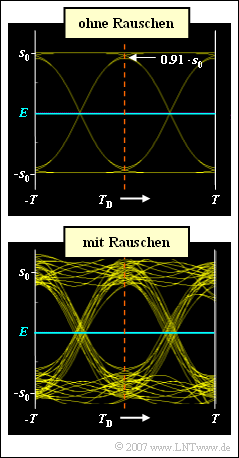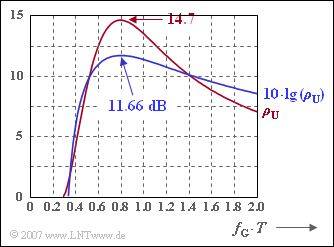Exercise 3.2Z: Optimum Cutoff Frequency for Gaussian Low-pass
As in Exercise 3.2, a binary bipolar redundancy-free binary system with Gaussian receiver filter $H_{\rm G}(f)$ is considered. Its cutoff frequency $f_{\rm G}$ is to be determined such that the worst-case S/N ratio
- $$\rho_{\rm U} = \frac{\big[\ddot{o}(T_{\rm D})/2 \big]^2}{ \sigma_d^2}\hspace{0.3cm}\Rightarrow \hspace{0.3cm} p_{\rm U} = {\rm Q} \left( \sqrt{\rho_{\rm U}} \right)$$
becomes maximum and thus the worst-case error probability $p_{\rm U}$ becomes minimum. The thus optimized cutoff frequency $f_{\rm G, \ opt}$ usually also leads to the minimum mean symbol error probability $p_{\rm S, \ min}$.
In the above equation, the following system quantities are used:
- $\sigma_d^2$ is the detection noise power. For Gaussian receiver filters holds:
- $$\sigma_d^2 = \frac{N_0}{2} \cdot \int_{-\infty}^{+\infty} |H_{\rm G}(f)|^2 \,{\rm d} f = \frac{N_0 \cdot f_{\rm G}}{\sqrt{2}}\hspace{0.05cm}.$$
- $\ddot{o}(T_{\rm D})$ indicates the eye opening. The detection time is always assumed to be $T_{\rm D} = 0$.
- For a Gaussian receiver filter, the vertical eye opening $\ddot{o}(T_{\rm D})$ can be expressed solely by the amplitude $s_0$ of the basic transmission pulse (upper boundary line in the eye diagram without noise) and the maximum value $g_0$ of the basic transmitter pulse.
- The pulse amplitude $g_0$ is to be calculated as follows:
- $$g_0 = g_d(t = 0) = s_0 \cdot \big [1- 2 \cdot {\rm Q} \left( \sqrt{2\pi} \cdot f_{\rm G} \cdot T \right)\big]\hspace{0.05cm}.$$
The graph shows the eye diagrams of the sought configuration with optimal cutoff frequency.
- In the upper diagram, the noise interferences are not considered.
- The lower diagram, on the other hand, is valid with AWGN noise for $10 \cdot {\rm lg} \ E_{\rm B}/N_0 = 10 \ \rm dB$.
Notes:
- The exercise belongs to the chapter "Error Probability with Intersymbol Interference".
- Use the interaction module "Complementary Gaussian Error Functions" for the numerical evaluation of the Q-function.
Questions
Solution
- When calculating the vertical eye opening, the noise component must not be taken into account. This is captured by the noise rms value $\sigma_d$.
- If the eye opening were taken from the lower eye diagram, the noise component would be captured twice.
- The upper boundary of the inner eye line results for the symbol sequence " $\text{ ...} \, \ -\hspace{-0.1cm}1 \ -\hspace{-0.1cm}1, +1, -\hspace{-0.1cm}1, \ -\hspace{-0.1cm}1, \text{ ...} $ " .
- The long "$-1$" sequence would lead to the value $-s_0$.
- In contrast, the "worst–case" sequence leads to the eye line $-s_0 + 2 \cdot g_d(t)$.
- Thus, at detection time $T_{\rm D} = 0$, with decision threshold $E = 0$:
- $${\ddot{o}(T_{\rm D})}/{ 2}= 2 \cdot g_0 - s_0 \hspace{0.05cm}.$$
(2) For the half vertical eye opening holds:
- $${\ddot{o}(T_{\rm D})}/{ 2} \ = \ 2 \cdot g_0 - s_0 = 2 \cdot s_0 \cdot\left [ 1- 2 \cdot {\rm Q} \left( \sqrt{2\pi} \cdot f_{\rm G} \cdot T \right)\right] - s_0 = s_0 \cdot\left [ 1- 4 \cdot {\rm Q} \left( \sqrt{2\pi} \cdot f_{\rm G} \cdot T \right)\right] \hspace{0.05cm}.$$
A closed eye results according to the given interaction module for
- $${\rm Q} \left( \sqrt{2\pi} \cdot f_{\rm G} \cdot T \right) \ge 0.25 \hspace{0.3cm}\Rightarrow \hspace{0.3cm} \sqrt{2\pi} \cdot f_{\rm G} \cdot T< 0.675\hspace{0.3cm}\Rightarrow \hspace{0.3cm} f_{\rm G, min} \cdot T \approx \frac{0.675}{2.5}\hspace{0.15cm}\underline { \approx 0.27} \hspace{0.05cm}.$$
(3) Using the equations on the information section and the previous calculations, we obtain
- $$\rho_{\rm U} = \frac{[\ddot{o}(T_{\rm D})/2]^2}{ \sigma_d^2} = \frac{s_0^2 \cdot\left [ 1- 4 \cdot {\rm Q} \left( \sqrt{2\pi} \cdot f_{\rm G} \cdot T \right)\right]^2}{ N_0 \cdot f_{\rm G} / \sqrt{2}}$$
With the specification $E_{\rm B}/N_0 = 10 \ \rm dB $, the following determining equation is obtained:
- $$10 \cdot {\rm lg}\hspace{0.1cm} {E_{\rm B}}/{ N_0} = 10 \, {\rm dB}\hspace{0.3cm}\Rightarrow \hspace{0.3cm} {E_{\rm B}}/{ N_0} = {s_0^2 \cdot T}/{ N_0} = 10$$
- $$\Rightarrow \hspace{0.3cm} \rho_{\rm U} = 10 \cdot \sqrt{2} \cdot \frac{ \left [ 1- 4 \cdot {\rm Q} \left( \sqrt{2\pi} \cdot f_{\rm G} \cdot T \right)\right]^2}{ f_{\rm G} \cdot T}\hspace{0.05cm}.$$
The figure shows this function plot as a function of the (normalized) cutoff frequency. For the given cutoff frequencies holds:
- $f_{\rm G} \cdot T = 0.6\text{:} \hspace{0.4cm} \rho_{\rm U} \approx 12.7 \Rightarrow 10 \cdot \rm lg \ \rho_{\rm U} \ \underline {\approx \ 11.04 \ \rm dB},$
- $f_{\rm G} \cdot T = 0.8\text{:} \hspace{0.4cm} \rho_{\rm U} \approx 14.7 \Rightarrow 10 \cdot \rm lg \ \rho_{\rm U} \ \underline {\approx \ 11.66 \ \rm dB},$
- $f_{\rm G} \cdot T = 1.0\text{:} \hspace{0.4cm} \rho_{\rm U} \approx 13.5 \Rightarrow 10 \cdot \rm lg \ \rho_{\rm U} \ \underline {\approx \ 11.30 \ \rm dB}.$
From the above graph, one can also see the minimum cutoff frequency ⇒ subtask (2).
(4) The first two solutions are correct:
- The validity of the first statement is evident from the above graph.
- Since in the above equation for $\rho_{\rm U}$ the ratio $E_{\rm B}/N_0$ occurs only as a factor, the optimization (setting the derivative to zero) always leads to the same result independent of $E_{\rm B}/N_0$.
- The optimal cutoff frequency with respect to $p_{\rm U}$ is approximately optimal with respect to $p_{\rm S}$ as well, but not exactly.
- For very large values of $E_{\rm B}/N_0$ (small noise), this approximation is very correct and $p_{\rm S} \ \approx \ p_{\rm U}/4$ holds.
- In contrast, for large noise, for example $10 \cdot {\rm lg} \ E_{\rm B}/N_0 = 0 \ \rm dB$, a smaller optimal cutoff frequency results when the optimization is based on $p_{\rm S}$:
- $f_{\rm G} \cdot T = 0.8\text{:} \hspace{0.4cm} p_{\rm U} = 0.113, p_{\rm S} = 0.102,$
- $f_{\rm G} \cdot T = 0.6\text{:} \hspace{0.4cm} p_{\rm U} = 0.129, p_{\rm S} = 0.094.$
- However, the error probabilities are then so large that these results are not practically relevant.
(5) With the result of subtask (2) ⇒ $E_{\rm B}/N_0 = 10$ and $f_{\rm G} \cdot T = 0.8$ holds:
- $${\ddot{o}(T_{\rm D})}/{ s_0} = 2 \cdot \left [ 1- 4 \cdot {\rm Q} \left( \sqrt{2\pi} \cdot 0.8 \right)\right] = 2 \cdot \left [ 1- 4 \cdot 0.022\right]\hspace{0.15cm}\underline { = 1.824} \hspace{0.05cm},$$
- $${\sigma_d^2}/{ s_0^2} = \frac{N_0 \cdot f_{\rm G} }{\sqrt{2}\cdot s_0^2}= \frac{N_0 }{s_0^2 \cdot T} \cdot \frac{f_{\rm G} \cdot T}{\sqrt{2}} = 0.1 \cdot \frac{0.8}{\sqrt{2}} \approx 0.0566 \hspace{0.3cm}\Rightarrow \hspace{0.3cm}{\sigma_d}/{ s_0}\hspace{0.15cm}\underline { \approx 0.238} \hspace{0.05cm},$$
- $$\rho_{\rm U} = \frac{[\ddot{o}(T_{\rm D})]^2}{ 4 \cdot \sigma_d^2} = \frac{1.824^2}{ 4 \cdot 0.0566}\approx 14.7 \hspace{0.3cm}\Rightarrow \hspace{0.3cm} 10 \cdot {\rm lg}\hspace{0.1cm} \rho_{\rm U}\hspace{0.15cm}\underline {\approx 11.66\, {\rm dB}} \hspace{0.05cm}.$$
- $$p_{\rm U} = {\rm Q} \left( \sqrt{\rho_{\rm U}} \right) = {\rm Q} \left( \sqrt{14.7} \right) \hspace{0.15cm}\underline { \approx 6.4 \cdot 10^{-5}}\hspace{0.05cm}.$$

